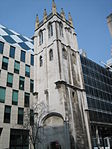St Mary Staining
12th-century church buildings in England1666 disestablishments in EnglandChurches destroyed in the Great Fire of London and not rebuiltChurches in the City of LondonFormer buildings and structures in the City of London ... and 2 more
London church stubsUnited Kingdom Anglican church building stubs

St. Mary Staining was a parish church in Oat Lane, northeast of St. Paul's Cathedral, in the City of London. First recorded in the 12th century, it was destroyed in the Great Fire of London in 1666 and not rebuilt.
Excerpt from the Wikipedia article St Mary Staining (License: CC BY-SA 3.0, Authors, Images).St Mary Staining
Oat Lane, City of London
Geographical coordinates (GPS) Address External links Nearby Places Show on map
Geographical coordinates (GPS)
| Latitude | Longitude |
|---|---|
| N 51.516666666667 ° | E -0.095 ° |
Address
St Mary Staining
Oat Lane
EC2V 7DE City of London
England, United Kingdom
Open on Google Maps








